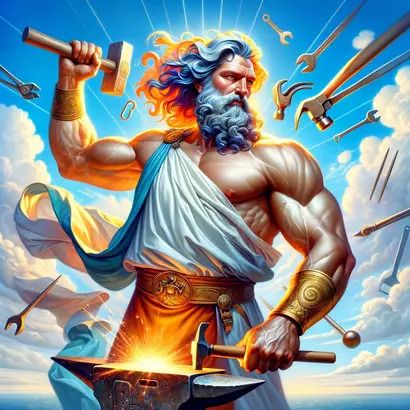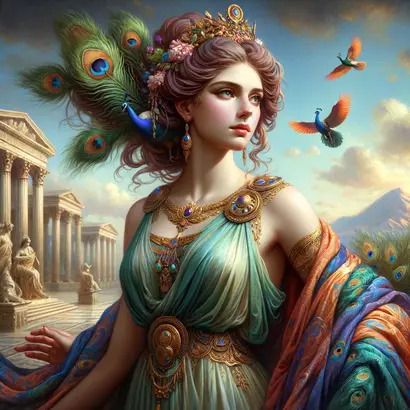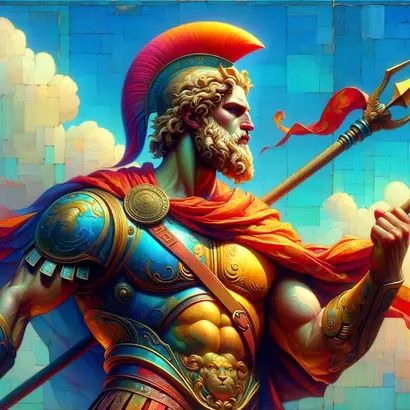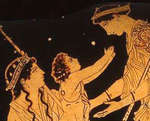
Hephaestus
⚒ Hephaestus :: Greek God of Blacksmiths and Fire
Hephaestus is the god of blacksmiths and fire. Called “the celestial artificer,” he was also associated with other craftsmen (sculptors, carpenters, metalworkers) and, as evident in the name of his Roman counterpart Vulcan, with volcanoes. Even though an ugly god lamed by his own mother, he was the husband of none other than Aphrodite herself.
Hephaestus’ Role
Hephaestus' Name
It is not known what the name Hephaestus means. However, since it’s similar to few pre-Greek toponyms (Phaistos), it is supposed that Hephaestus is a very old deity.
Hephaestus' Portrayal and Symbolism
He is arguably the most extraordinary member of the Olympian Pantheon. Bearded and ugly, stocky and lame, he neither possesses the physical flawlessness of the other gods nor does he stimulate the fitting respect. Sometimes he is depicted with an oval cap and almost always with a hammer and an anvil.
Hephaestus' Epithets
The epithets most commonly associated with Hephaestus are far from flattering: “the lame one” and “the halting.” He is also sometimes referred to as “shrewd” and habitually as the “Aetnaean,” since his workshop was believed to be located under Mount Aetna.
Hephaestus’ Family and Difficult Childhood
Son of Zeus and Hera
Homer says that Hephaestus was the son of Zeus and Hera. However, he is unclear whether he was born lame or whether he was lamed after his father threw him from Olympus for intervening on behalf of his mother during a quarrel between Zeus and Hera.
Hephaestus Hated by His Mother
Hesiod, however, claims that Hephaestus is solely Hera’s child and that she gave him birth by parthenogenesis to get back at her husband who had done the same with Athena. In this version of the story, after bringing him to the world, Hera was so disgusted with Hephaestus’ looks and ashamed of his deformity that she was the one who threw him out. Hephaestus was severely hurt from the fall, but he was rescued by Thetis and Eurynome, who sheltered him in a cave under the Ocean for the following nine years.
Hephaestus’ Revenge on Hera
Later on, Hephaestus got his revenge. He made a golden throne, so beautiful that Hera accepted it right away. However, the minute she sat on it, she was all tied up by the numerous delicately fashioned cords invisible to anyone’s eyes but their creator’s. Many gods tried to persuade Hephaestus to free Hera, promising him a place on Olympus in return. However, he was unremorseful and released his mother only when Dionysus got him drunk.
Hephaestus as a Craftsman
Just like Hera’s golden throne, Hephaestus’ creations were masterworks.
Hephaestus' Architectural Wonders
No one but him was able to build the beautiful, indestructible bronze mansions where all the other Olympians lived. Crafty and cunning, he added a distinctive element here and there, such as the secure doors of Hera’s chamber which no other god but her could open.
Hephaestus' Automata
In the “Iliad,” Homer tells us something even more fascinating. Namely, that Hephaestus had fashioned for himself handmaidens of gold, who were able to understand him, speak to him and assist him. And they weren’t the only creations of this kind. Among other automata, Hephaestus sculpted golden dogs to guard the palace of Alcinous and Talos, a giant bronze man to protect Crete. Some even say that, at the request of Zeus, he also sculpted the first mortal woman, Pandora.
Hephaestus' Arms and Armor
Finally, Hephaestus was the creator of some of the most stunning pieces of military equipment ever seen. Most famously, as a favor to Thetis, he created the shield of Achilles, whose five bronze layers he masterfully engraved with scenes representing almost all aspects of life. But he was also the one who made the scepter of Agamemnon, the breast-plate of Diomedes, and the sword of Peleus.
Hephaestus’ Women and Children
For an ugly god, Hephaestus couldn’t have fared much better when it comes to women.
Hephaestus and Aphrodite
Most commonly, his wife is said to have been none other than Aphrodite, the Goddess of Beauty herself. However, she wasn’t very faithful to him, sleeping with Ares behind his back. One day, Hephaestus caught the lovers and trapped them in a fine-woven chain-net, after which he called upon the other gods to laugh at their shame. Poseidon persuaded him to free the adulterers, but Hephaestus wasn’t done. When Ares and Aphrodite’s daughter Harmonia married Cadmus, he gifted her a magical necklace which would bring misfortune to her and everyone who will afterward wear it.
Hephaestus and Aglaea
Other authors say that Hephaestus was married to Aglaea, the youngest of the Graces. She gave him four children: Eucleia, Euthenia, Eupheme, and Philophrosyne.
Hephaestus and Athena
One time, Hephaestus tried to force himself upon Athena. Athena managed to escape on time, so Hephaestus’ seed fell on the earth and impregnated Gaea, who afterward gave birth to Erichthonius, an early ruler of Athens.
Hephaestus: Myths and Hidden Truths
One common misconception about Hephaestus is that he was a weak and insignificant god due to his physical deformity. In reality, Hephaestus was highly respected and admired for his incredible craftsmanship and innovative creations. He played a crucial role in the construction of the gods' dwellings and the forging of their weapons. Another misconception is that Hephaestus was constantly ridiculed by the other gods for his appearance. While it is true that some stories depict him as being mocked, he was also valued for his unique abilities and contributions to the pantheon.
Hephaestus' Mechanical legs
A lesser-known fact about Hephaestus is that he was sometimes considered a patron of the arts. His exceptional skill in crafting exquisite sculptures and other artistic creations led to his association with artists and their work. Additionally, Hephaestus was known to have crafted his own set of mechanical, self-propelled legs to help him overcome his lameness. This ingenious invention not only demonstrates his talent as a craftsman but also his resilience in overcoming the challenges he faced due to his disability.
Hephaestus: Celestial Artificer and Master Craftsman
In our exploration of Hephaestus' stories and myths, we have come to appreciate the depth and complexity of this fascinating god. Despite his physical imperfections, Hephaestus proved to be a powerful and resourceful deity, capable of creating wonders that amazed both gods and mortals alike. We've been particularly impressed with his ability to craft intricate, lifelike automata, showcasing his unparalleled talent as an inventor and visionary.
As we delved deeper into Hephaestus' world, we also discovered his resilience and determination, as he refused to let his disability define him. The creation of his mechanical legs, along with his numerous other accomplishments, serves as a testament to his unwavering spirit and ingenuity. Hephaestus' story has inspired us to persevere in the face of adversity and to embrace our unique qualities, using them to forge our own paths in life.
Hephaestus Sources
Read the brief “Homeric Hymn to Hephaestus” and see how eloquently the Ancient Greeks asked for his help. In Hesiod’s “Works and Days,” you can find out how he molded Pandora. On Hephaestus’ automata and the imagery on Achilles’ shield, see Homer’s descriptions in the “Iliad.”
See Also: Hera, Aphrodite, Ares, Erichthonius
Hephaestus Video
Hephaestus Q&A
Hephaestus Associations
Link/Cite Hephaestus Page
Written by: The Editors of GreekMythology.com. GreekMythology.com editors write, review and revise subject areas in which they have extensive knowledge based on their working experience or advanced studies.
For MLA style citation use: GreekMythology.com, The Editors of Website. "Hephaestus". GreekMythology.com Website, 19 Apr. 2023, https://www.greekmythology.com/Olympians/Hephaestus/hephaestus.html. Accessed 26 April 2024.




